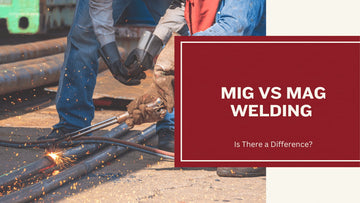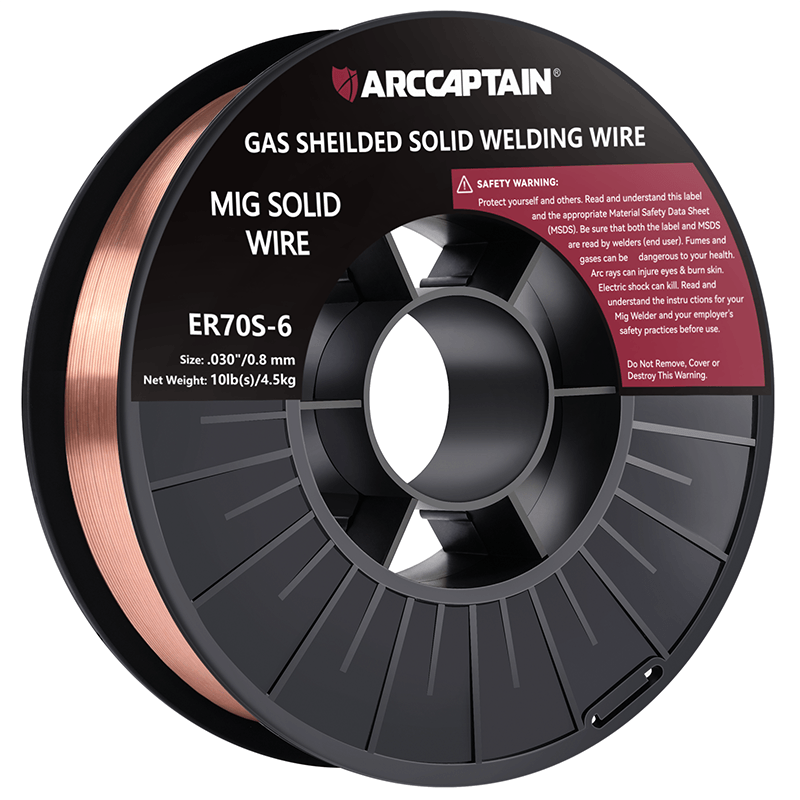
If you're interested in welding, you've probably come across the terms MIG and MAG welding. Both of these welding processes fall under the umbrella term "gas metal arc welding" (GMAW). However, there is one significant difference between the two: the type of shielding gas used.
In this article, we'll explore the difference between MIG and MAG welding, as well as what each process is best used for. Whether you're in the manufacturing, construction, or automotive industry, understanding these two fusion welding processes is crucial for producing high-quality metal pieces. So, let's dive in and learn more about MIG and MAG welding!
How Does Gas Metal Arc Welding Works
Gas metal arc welding (GMAW) is a welding process that uses a consumable electrode (solid wire) under the protection of a shielding gas to join metal. The solid metal wire is pushed via an automated wire feeder through the MIG gun and energized via a power source. The welding gun machine combines a wire feeder and a power source into one unit.
GMAW works by short-circuiting electricity released from the welding machine. The ground clamp is attached to the positive terminal, while the MIG gun is negative. When you grip the welded material with the ground clamp and the positive wire (coming from the MIG welding gun) touches the metal, the electrical short occurs, melting the wire and a piece of the welding joint. The metal melts due to internal resistance to the flow of electrons in the circuit.
As the wire melts away, it deposits a metal droplet into the joint. Then, the wire feeder pushes more wire to short with the metal, and this process keeps repeating many times per second. This gives GMAW its characteristic sizzling sound and causes the spatter. Every time the wire shorts with the grounded metal, the sparks and spatter fly around because shorting works like a small explosion.
The most common GMAW metal transfer method is called "short circuit metal transfer." There are also other GMAW transfer methods like spray, globular, and pulse transfer. But, these are more advanced and out of this article scope.
GMAW is a versatile process that can be used to weld a variety of metals, including ferrous and non-ferrous metals like steel, stainless steel, copper, nickel, titanium, and aluminum. It is particularly useful for welding thin metals and thicker materials, as well as for deep penetration welds. The deposition rate is high, and the heat input is low, which means that the weld puddle and weld bead are small. This makes GMAW ideal for welding in tight spaces, and for welding materials that are sensitive to heat.
The choice of shielding gas depends on the base metal being welded and the desired weld penetration. For example, when welding mild steel, a mixture of argon and carbon dioxide is commonly used. When welding aluminum, pure argon is used. The shielding gas protects the weld pool from harmful atmospheric gases and helps to stabilize the arc.
In summary, GMAW is a popular welding process that uses a consumable electrode (solid wire) under the protection of a shielding gas to join metal. It is a versatile process that can be used to weld a variety of metals, and is particularly useful for welding thin metals and thicker materials, as well as for deep penetration welds.
MIG - Metal Inert Gas Welding Process
MIG welding, also known as Metal Inert Gas welding, is a welding process that uses inert gases like argon and helium to shield the weld puddle from atmospheric contamination. Inert gases don't chemically interact with the molten metal, so they don't influence the weld to a large extent. Argon gas is commonly used for MIG welding of nonferrous materials like aluminum, magnesium, copper, and nickel or its alloys. However, you cannot use 100% argon gas to weld ferrous metals like steel.
The advantages of using inert welding gas in MIG welding include producing a favorable atmosphere in the weld puddle that's very easy to ionize, so keeping a long arc with lower voltage is relatively easy. Helium can be added to argon to increase arc heat, puddle fluidity, and weld penetration. However, using 100% helium to weld very thick sections of aluminum or magnesium will reduce arc stability.
In summary, MIG welding uses inert gases to protect the weld from contamination, and argon is commonly used for nonferrous materials while helium can be added to increase penetration. However, 100% helium should be used with caution as it can reduce arc stability.
MAG - Metal Active Gas Welding Process
MAG welding, also known as Metal Active Gas welding, is a welding process that uses active gas or a combination of active and inert gases. The active or reactive gases used in MAG welding directly influence the weld penetration, puddle fluidity, arc stability, weld spatter, and the resulting bead.
The two most commonly used reactive shielding gases for MAG welding are oxygen and carbon dioxide. Oxygen is only used as an addition to argon, while it's possible to weld with 100% CO2. However, you cannot efficiently weld steel with 100% argon because the uneven iron oxides on the steel surface emit electrons that attract the arc in unpredictable directions. As a result, the weld deposits are irregular, and it becomes challenging to create a uniform weld.
Mixing oxygen with argon creates a reaction on the steel surface that results in a uniform iron oxide surface. This provides a stable path for the arc to follow and allows you to lay beautiful welds. However, it's rare for regular folks to use oxygen and argon blend. Carbon dioxide provides an excellent substitute for oxygen.
The most common shielding gas employed in GMAW is a blend of 75% argon and 25% CO2. Adding carbon dioxide to argon creates a more favorable weld bead and a deeper penetration. Plus, the arc is more stable if using argon/CO2 than argon/O2.
However, using reactive gases like oxygen and carbon dioxide can cause porosity, so it's essential to use a MIG welding wire that contains deoxidizers. For example, the Arccaptain ER70S-6 Welding Wire - solid wires contain enough manganese and silicon deoxidizers so that they can even be used with a 100% CO2 shielding gas.

MAG welding with a pure CO2 gas produces very deep weld penetration, but it does cause more spatter and produces slightly less appealing welds compared to the 75/25 mixture discussed earlier. If you have enough skills to weld with a very short arc, you can mitigate the increased spatter. Just make sure you use a wire designed for welding with 100% CO2.
In summary, MAG welding is a welding process that uses active gas mixtures, such as oxygen and carbon dioxide, to produce a stable path for the arc to follow. While it has advantages such as deep penetration, it also has its disadvantages, such as spatter and contamination. However, by using the right shielding gas and MIG welding wire, you can mitigate these issues and produce beautiful welds.
Conclusion
In conclusion, while there is a technical difference between MIG and MAG welding, the two terms are often used interchangeably in the industry. This is because most professionals know which shielding gas to use with each metal, and there is little to no harm caused by using the wrong term in everyday welding work.
When it comes to choosing between MIG and MAG welding, it ultimately depends on the project's requirements and personal preference. While MIG welding is more versatile and easier to practice, it can be more expensive due to the cost of the shielding gas. On the other hand, MAG welding is more cost-effective and produces strong bonds with high-quality welds, but it requires more safety precautions due to the toxic nature of the shielding gas.
In summary, both MIG and MAG welding have their advantages and disadvantages. It is important to weigh the cost, mechanical properties, and safety considerations when choosing between the two processes. With the right practice and knowledge, you can achieve high-quality welds with either method.
Frequently Asked Questions
What distinguishes MIG welding from MAG welding?
MIG welding and MAG welding are similar in many ways, but the biggest way they differ is in their shielding gas. MIG welding uses an inert gas, while MAG welding uses active gases. In MIG welding, the shielding gas is a gas used at the welding torch to help prevent the weld from oxidizing due to the oxygen in the surrounding atmosphere. MAG welding, on the other hand, uses active gas mixtures that have been developed to provide greater welding speeds and deeper penetration.
Can you explain the differences in gas usage between MIG and MAG welding?
MIG welding uses inert gases like argon and helium, while MAG welding uses active gas mixtures like carbon dioxide, oxygen, and argon. The choice of gas depends on the type of metal being welded, the thickness of the metal, and the desired weld characteristics. In general, MIG welding is used for welding non-ferrous metals like aluminum, while MAG welding is used for welding ferrous metals like steel.
What are the primary applications for MAG welding?
MAG welding is commonly used in the automotive and construction industries for welding steel structures, pipelines, and other heavy-duty applications. It is also used in shipbuilding, aerospace, and other industries where high-quality welds are required.
What are the advantages and disadvantages of using MAG welding over other types?
MAG welding offers several advantages over other welding processes, including high welding speeds, deep penetration, and low levels of spatter. However, it also has some disadvantages, such as the need for a constant supply of gas and the potential for porosity and other defects in the weld.
In what scenarios would one opt for MIG welding instead of MAG welding?
MIG welding is typically used for welding non-ferrous metals like aluminum, while MAG welding is used for welding ferrous metals like steel. So, if you are working with aluminum, you would opt for MIG welding, while if you are working with steel, you would opt for MAG welding.
How do the materials used in MIG and MAG welding processes differ?
The materials used in MIG and MAG welding processes differ mainly in the type of gas used for shielding. MIG welding uses inert gases like argon and helium, while MAG welding uses active gas mixtures like carbon dioxide, oxygen, and argon. The type of gas used depends on the type of metal being welded, the thickness of the metal, and the desired weld characteristics.
